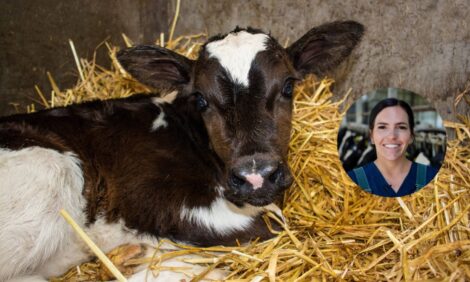



Dairy Cow Welfare Strategy 2011 Report
In a move towards improving the welfare of dairy cows, the Dairy Welfare Strategy was created, setting out targets and guidelines for the indusry. The results of the 2011 report have now been published by the Cattle Health and Welfare Group (CHAWG). The latest report highlights the progress of the strategies so far.The Dairy Cow Welfare Strategy, developed by the NFU in conjunction with the dairy sector, was launched in August 2010 with the support of the whole supply chain.
In order to implement a successfully strategy for providing dairy cow welfare, a series of priorities were set up, each with its own targets, to be able to both set attainable goals and, as a way to review the progress of the welfare strategy.
A summary of the review of each priority and its targets is presented below.
Priority 1 - Better on-farm recording and use of aggregate data
This priority required all farmers to record any incidence of mastitis, lameness and the reasons for culling and, to share aggregate data with the industry. It also required the data set to be analysed in 2011. So far, CHAWG report that these are on target, with the number of cases being reported rising.
A national system to collate data on dairy cow production, health and welfare trends and measures is in the development phase, with many milk recording organisations giving their permission for the use of their data.
Also underway is the development of a database providing data for fertility, calving ease and some mastitis data. This will soon be able to produce data by year, breed and by the cow lactation number.
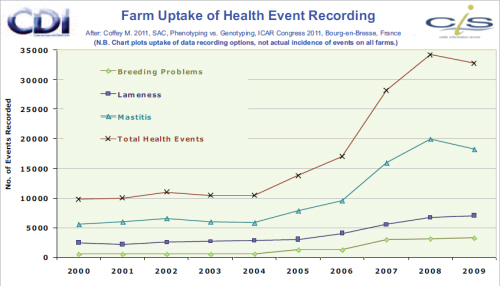
Priority 2 - Mastitis: Improvement in recognition, treatment, prevention and control
With this priority also on target, the aim was for 750 farm plans to be developed by 2012.
DairyCo reports that for their Mastitis Control Plan to the end of June 2011, 224 delegates (predominantly vets) have attended the dedicated training course, with a total of 756 farms registering to participate in the scheme.
Of these, 180 have so far submitted data twelve months following registration on the scheme. This number is expected to continue to grow.
The incidence rate of cows affected by clinical mastitis (expressed as the proportion of cows affected) has also reduced by 7.8 per cent over the last 12 months to June 2011.
Priority 3 - Lameness Improvement in recognition, treatment, prevention and control
The target of a 2011 launch was met but the target of providing 200 foot trimmers on the NACFT website still requires further work.
Alongside the production of guides, meetings and mentor programmes, other efforts towards lameness mitigation include DairyCo's Healthy Feet Programme.
Mentoring includes independent mobility scoring at least twice a year for herds, a skills assessment of the farm staff involved in foot care, and an assessment of the risk factors on the farm to identify the major causes/reasons behind lameness incidence.
The national ‘launch’ of the mentor programme took place at the 2011 Dairy Event and Livestock Show. To ensure that dairy farmers are kept up to date with the latest scientific advances, DairyCo has also launched a five-year research partnership with a number of leading research establishments.
So far, NACFT provides 79, of the targeted 200, foot trimmers on its website. The range of trimmers listed on the site come from all six trimmer categories.
Priority 4 - Understanding infertility
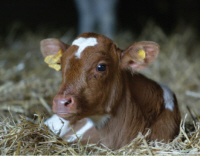
Infertility in the dairy cow continues to be a challenge for many dairy farmers and requires a unique plan based on the requirement of individual cows in the correct balance to achieve maximum conception rates.
The priority 4 target, of a campaign / programme to be scoped and developed by 2012, still needs more work as although there is not yet a plan laid out, local organisations have started their commitments to supporting dairy farms.
The British Cattle Veterinary Association (BCVA) is also engaged with the issue of fertility through a proffesional development course for undergraduate/ graduate vets.
DairyCo also currently provides an up to date fertility management manual for dairy farmers and has committed to reviewing existing knowledge and identify where any future initiative would best sit.
Priority 5 - Cow nutrition
The nutrition of the dairy cow is an important assessment area of the Red Tractor Assurance Dairy Scheme (RTA Dairy). In light of this, two targets; 10 per cent of British dairy farmers regularly body condition scoring their herds and 10 per cent of dairy farmers attending DairyCo feeding+ events by 2012 (or similar) were set up. Currently, both targets require further work.
So far, 3,000 DairyCo feeding+ manuals have been distributed to the dairy sector, they provide the latest nutrient knowledge and techniques. DairyCo has also provided factsheets to aid with the understanding of the importance and impact of changes in dairy cow body condition score during lactation.
In addition, a number of retailers/milk purchasers have incorporated a body condition score component into their supply agreements with producers which will aid the implementation of this management technique.
Priority 6 - Addressing welfare through Farm Assurance
So far, the target of the incorporation of welfare outcome measures in future review has been met but the reduction in number of farmers classified as ‘high risk’ by RTA Dairy Scheme target requires further work.
The latest version of the dairy farm assurance standards was introduced in April 2010. This incorporated a substantive change in layout as part of a harmonisation project for the Red Tractor schemes across all sectors.
To reduce the number of 'high risk' farnmers, measures include more frequent routine visits, revisits to check rectification and increased likelihood of a spot check.
The inclusion of objective welfare outcome measures has been a desire of the scheme for several years. Progress was limited however, as, although there have been increasing amounts of information about outcomes from research such as the EU Welfare Quality project, the most appropriate measures that could be practically incorporated into routine assurance assessments were not adequately defined.
Priority 7 - Improving welfare through breeding programmes
The target of all farmers being aware of breeding+ has not been fully met.
All major breeding companies support DairyCo’s breeding+ programme and use its results, as well as promoting the breeding+ logo, in their bull catalogues. This data is estimated to be utilised by the vast majority of dairy farmers (>75 per cent).
The movement towards meeting this target has been developed by knowledge transfer through farmer meetings, press articles and publications. The development of the National Fertility Index is also improving fertility rates.
Genetic measures of the national herd also plays an important part in establishing the current state and future goal for the industry in terms of health, welfare and longevity. Genetic development will continue to be focused on the development of new traits, more accurate predictions and more information about bulls, as more useful and better standards of on-farm recording are developed.
The DairyCo breeding+ programme is available in a 24 page booklet titled ‘Breeding briefs’ which is available as a free download from the DairyCo website and has been handed out at conferences and meetings since January 2011.
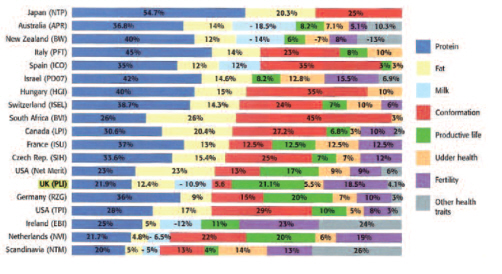
Priority 8 - Informing and educating the consumer
The two targets of, a website promoted by all stakeholders and, improvement in consumer knowledge of dairy farming have both been successfully completed.
DairyCo launched the website, www.thisisdairyfarming.com. This is the main route for providing information to the public about British dairy farming methods and the welfare standards achieved by British dairy farmers.
This website has been promoted by and linked with all the main industry trade associations and has been recognised by senior policy makers.
Consumer awareness of the Red Tractor logo on assured food products also continues to grow.
In relation to consumer-facing dairy welfare literature and point of sale information, all retailers are promoting the way they are helping their milk suppliers improve welfare through on-pack labelling, instore promotions and retailer magazines.
Campaigns and leafleting from the EU, NFU and DairyCo have also helped to raise awareness.
Priority 9 - Preparing for the future
So far the target of two annuall briefing days in addition to current industry events has been met but, a clear protocol in place for farmers and the industry on dealing with welfare and other sector issues, requires further work.
The Cattle Health and Welfare Group will publish an annual report against the ten recommendations recognised in the Dairy Cow Welfare Strategy. In future these recommendations will be reviewed and changed as necessary.
This report will set the basis against which future reports will be structured. The industry continues to take the welfare of the dairy cow seriously and will continue to review the priorities to ensure they remain focused and applicable to dairy cows’ needs.
Traditionally the industry has had a disparate approach to health and welfare activities. The role of CHAWG is to bring these activities under one umbrella and enable a more focused and co-ordinated approach, reducing the risk of duplication of effort and capitalising on resource efficiency by the sector.
Through this report and other activities, CHAWG asks the industry to keep it informed of dairy cow welfare activities so that the knowledge base can continue to be grown and shared with colleagues, with the aim of continued, focused and measurable improvement.
The CHAWG has an agreement with the Animal Health Veterinary Laboratories Agency (AHVLA) on new and emerging health and welfare issues. Before any public announcement, the AHVLA will first consult with CHAWG to ensure that what is being proposed in terms of communications and on-farm actions is discussed and agreed with the group first. This ensures a consistent message and importantly a joined up approach from the sector in moving forward.
Over the past year, Retailers, such as Morrisons, Processors, such as First Milk Academy and the now disbanded Regional Development Agencies have organised and held numerous meetings focusing on cattle health & welfare issues. The meetings often focussed on ivestment, health, safety, welfare, product quality and profiability.
Furthermore, DairyCo provides a number of opportunities through which farmers can learn more about welfare, including workshops, farm walks, and ‘impact groups’.
Dairy farmers, through DairyCo, have also funded their own public relations resources to help promote to the general public the good work done in caring for cows and the countryside.
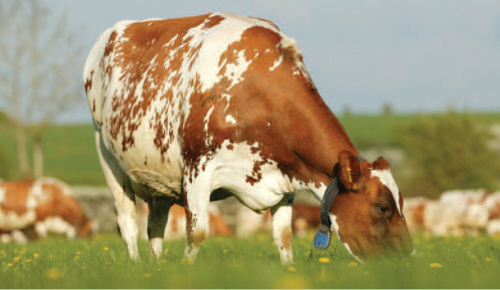
Priority 10 - Industry co-ordination
The two targets for this section; publish annual report and issue statements to be reviewed regularly and new issues identified, were both acheived.
Currently there are 26 approved issue / media statements covering topics such as; mastitis, lameness and large scale dairy farming and a further 12 are work in progress. These are important for communication with the general public over matters of interest.
CHAWG also liaises closely with the Chief Veterinary Officers (CVO’s) of Scotland and Wales, as well as the UK, in the identification and addressing of dairy cow welfare issues. CHAWG provides the CVO’s with a ‘one stop shop’ for the discussion of key and at times sensitive issues related to dairy cow welfare. CHAWG is able to provide this because of the wide range of organisations represented at the table results in a genuine ‘industry’ viewpoint and an all-encompassing collaborative approach to solving identified issues.
Conclusion
This report clearly demonstrates the positive progress made by the industry towards the agreed targets. Having said that, the Cattle Health and Welfare Group recognise that there is still a long way to go.
The CHAWG will maintain this Strategy as one of its key work items and will continue to challenge the industry on its delivery.
Importantly the CHAWG will continually review the targets in relation to appropriateness, indicator measures and scientific advancement to ensure continued, relevant momentum against the stated timescales.
The CHAWG would like to take this opportunity to thank those who have provided input to this review and encourage those that feel they could contribute to our efforts to make contact with the CHAWG secretariat to discuss how this can be done

